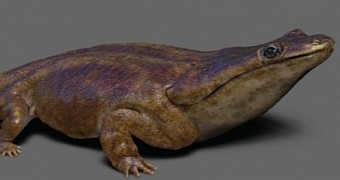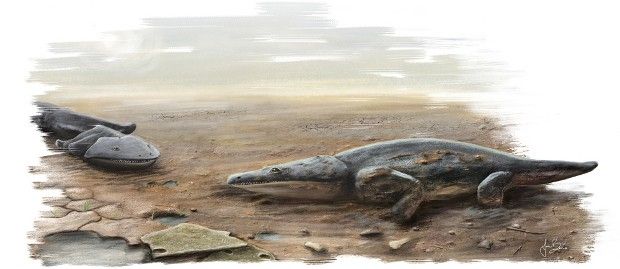A new study in the Journal of Vertebrate Paleontology describes a prehistoric scary-looking amphibian that roamed the Earth a couple of hundred million years ago and that counts itself among the forefathers of the frogs and salamanders currently populating our planet.
The uncanny species, now known to the scientific community as Metoposaurus algarvensis, was identified with the help of fossilized remains pulled from sediment deposits left behind by an ancient lake in present-day southern Portugal.
This prehistoric amphibian was a top predator
Writing in the Journal of Vertebrate Paleontology, scientists at the University of Edinburgh in Scotland and colleagues explain that, unlike the amphibians we are familiar with, this ancient creature was seriously oversized.
The fossils found in Portugal indicate that adult Metoposaurus algarvensis measured about 2 meters (roughly 6.5 feet) from head to tail. That's right, these prehistoric amphibians were the size of cars.
The species inhabited lakes and rivers. To satisfy the hearty appetite that came with their big body, the creatures hunted and ate fish. They were such gifted predators that, in a way, they were more like crocodiles than like salamanders.
The researchers who documented this new species insist that Metoposaurus algarvensis specimens had heads resembling toilet seats, as illustrated in the images accompanying this article. Still, nobody ever dared made fun of them.
This is because the amphibians’ funny-looking heads came complete with mouths that packed hundreds of sharp teeth. In fact, word has it that these teeth made the creatures look like the stars of some ancient monster movie.
The species thrived on Earth about 220-230 million years back. It went extinct 200 million years ago, at the end of the Triassic Period, together with many other vertebrates. Following this mass extinction, dinosaurs became Earth's ultimate rulers.
A better understanding of ancient biodiversity
Fossilized remains of ancient amphibians have so far been discovered all across the globe, Africa, Europe, India and North America included. What with the discovery of Metoposaurus algarvensis in Portugal, researchers know more about biodiversity in ancient times.
“The discovery reveals that this group of amphibians was more geographically diverse than previously thought. The species is the first member of the group to be discovered in the Iberian Peninsula,” explained the University of Edinburgh scientists behind this find.

 14 DAY TRIAL //
14 DAY TRIAL // 

